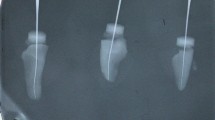Abstract
Aim
To evaluate ex vivo the accuracy of the multifrequency electronic apex locator (EAL) Joypex 5 in primary molars.
Methods
Fourteen primary molars were selected for a total of 25 root canals. Working length measurements were performed by direct observation (DO), using a 15 K-file into the root canal until its tip was visible at the apical foramen and electronically using the EALs Joypex 5. Data were analysed statistically using the intraclass correlation coefficient (ICC). To assess whether a significant difference in accuracy of the electronic apex locator existed, the Student’s t test was performed at 5 % significance.
Results
No statistical difference was observed between the direct observation and the EAL measurement (p < 0.05). The ICC confirmed the agreement of different methods to measure canal length. The R 2 coefficient was close to 1, denoting a strong agreement between measures obtained with Joypex 5 and DO.
Conclusion
The multifrequency EALs Joypex 5 showed adequate accuracy in the root length determination of primary teeth.

Similar content being viewed by others
References
Angwaravong O, Panitvisai P. Accuracy of an electronic apex locator in primary teeth with root resorption. Int Endod J. 2009;42:115–21.
Azar MR, Mokhtare M. Rotary Mtwo system versus manual K-file instruments: efficacy in preparing primary and permanent molar root canals. Indian J Dent Res. 2011;22:363.
Beltrame AP, Triches TC, Sartori N, Bolan M. Electronic determination of root canal working length in primary molar teeth: na in vivo and ex vivo study. Int Endod J. 2011;44:402–6.
Brunton PA, Abdeen D, MacFarlane TV. The effect of an apex locator on exposure to radiation during endodontic therapy. J Endod. 2002;28:524–6.
de Vardasca Oliveira PT, Chita JJ, Silva PG, De Vicente FS, Pereira KF. Accuracy of two apex locators made in China compared to Root ZX II. Pesq Bras Odontoped Clin Integr. 2010;10:83–8.
ElAyouti A, Weiger R, Lost C. Frequency of overinstrumentation with an acceptable radiographic working length. J Endod. 2001;27:49–52.
Fuks AB, Eidelman E. Pulp therapy in the primary dentition. Cur Opin Dent. 1991;1:556–63.
Katz A, Mass E, Kaufman AY. Electronic apex locator: a useful tool for root canal treatment in the primary dentition. J Dent Child. 1996;63:414–7.
Kielbassa AM, Muller U, Munz I, Monting JS. Clinical evaluation of the measuring accuracy of Root ZX in primary teeth. O Surg O Med O Pathol O Radiol Endod. 2003;95:94–100.
Leonardo MR, Silva LA, Nelson-Filho P, Silva RA, Raffaini MS. Ex vivo evaluation of the accuracy of two electronic apex locators during root canal length determination in primary teeth. Int Endod J. 2008;41:317–21.
Leonardo MR, da Silva LA, Nelson-Filho P, da Silva RA, Lucisano MP. Ex vivo accuracy of an apex locator using digital signal processing in primary teeth. Ped Dent. 2009;31:320–2.
Majeed MA, Subhi AG. Assessment of the accuracy of a fifth generation apex locator (in vitro study). J Bagh Col Dent. 2011;23:12–7.
Mello-Moura ACV, Moura-Netto C, Araki AT, Guedes-Pinto AC, Mendes FM. Ex vivo performance of five methods for root canal length determination in primary anterior teeth. Int Endod J. 2010;43:142–7.
Nekoofar MH, Ghandi MM, Hayes SJ, Dummer PM. The fundamental operating principles of electronic root canal length measurement devices. Int Endod J. 2006;39:595–609.
Nelson-Filho P, Romualdo PC, Bonifácio KC, Leonardo MR, Silva RA, Silva LA. Accuracy of the iPex multi-frequency electronic apex locator in primary molars: an ex vivo study. Int Endod J. 2011;44:303–6.
Ricucci D. Apical limit of root canal instrumentation and obturation. Part 1. Int Endod J. 1998;31:384–93.
Ruschel HC, Ligocki GD, Flaminghi DL, Fossati AC. Microstructure of mineralized tissues in human primary teeth. J Clin Pediatr Dent. 2011;35:295–300.
Saritha S, Uloopi KS, Vinay C. Chandra Sekhar R, Rao VV. Clinical evaluation of Root ZX II electronic apex locator in primary teeth. Eur Arch Paediatr Dent. 2012;13:32–5.
Schaeffer MA, White RR, Walton RE. Determining the optimal obturation length: a meta-analysis of literature. J Endod. 2005;31:271–4.
Soares RM, Silva EJ, Herrera DR, Krebs RL, Coutinho-Filho TS. Evaluation of Joypex 5 and Root ZX II: an in vivo and ex vivo study. Int Endod J. 2013 [Epud ahead of print].
Tosun G, Erdemir A, Eldeniz AU, Sermet U, Sener Y. Accuracy of two electronic apex locators in primary teeth with and without apical resorption: a laboratory study. Int Endod J. 2008;41:436–41.
Author information
Authors and Affiliations
Corresponding author
Rights and permissions
About this article
Cite this article
Silva, E.J.N.L., Herrera, D.R., Souza-Júnior, E.J. et al. Evaluation of the multifrequency electronic apex locator Joypex 5 in primary teeth. Eur Arch Paediatr Dent 15, 51–54 (2014). https://doi.org/10.1007/s40368-013-0065-0
Received:
Accepted:
Published:
Issue Date:
DOI: https://doi.org/10.1007/s40368-013-0065-0




